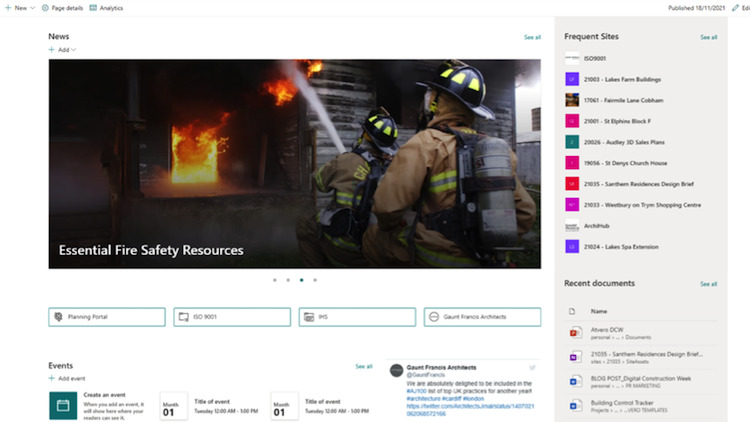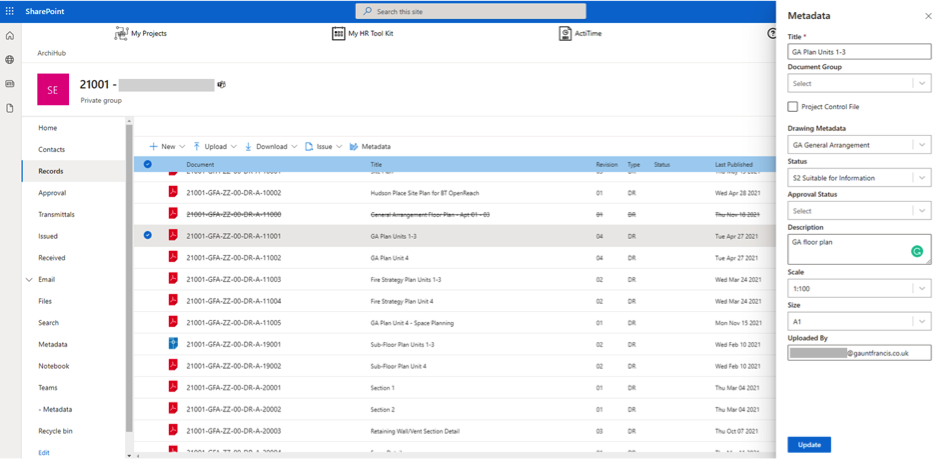
How do you implement a common data environment (CDE) when you’re a small business and you’ve got more than enough on your hands running your business? Toby Adam, director at Gaunt Francis Architects, shares his experience.
CDEs are rarely ever delivered on a budget, and are traditionally procured as extranets, a controlled private network allowing customers, partners, vendors, suppliers and other businesses to upload and download documents to and from a third-party technology provider, typically in the context of delivering a construction project, and do so without granting access to the organisation’s entire network.
Gaunt Francis Architects is a medium-sized commercial practice of about 45 people, with two offices – one in London and another in Cardiff – that started in 1997 and has since built a reputation, originally for commercial projects and more lately as a leader in the retirement living sector.
Like many architectural practices of our size, we sit in that awkward space where we are large enough to require some non-architectural support staff, but not big enough to make this an obviously clear decision. Our IT manager works across an incredibly diverse spectrum of activity, from on-boarding new recruits, managing software subscriptions and networks, to physically maintaining machines, operating the 3D printer and managing the VR rig.
Like many small businesses, we have ended up with a plethora of off-the-peg software solutions and subscriptions to deal with the various workflows – HR management, accounts, CAD, email, productivity, video conferencing, etc. Usually, this happens via incremental growth: a problem is identified, a solution is found, and yet another subscription is added to the list. We are not large enough to buy bespoke software solutions as the economies of scale just don’t apply.
We wanted to find a pragmatic rather than a cost-prohibitive solution to deliver better information management and project record keeping (namely the identification, storage, and transmittal of formal project data in the form of letters, drawings, schedules etc) across all RIBA Stages, from inception to completion.

“The CDE we use now is designed to make use of the more powerful and rapid search abilities of SharePoint, but also the use of metadata that goes beyond just the title of the drawing. This system knows what the data is, so where it is matters less.”
We had concluded that our historic system of data management, based on the use of files created in File Explorer – a replica of an old-fashioned filing cabinet type system – was no longer fit for purpose and that we needed to find a new solution.
We were aware of the growing use of CDEs and we knew that there were solutions out there that combined data management, CRM (customer relationship management), cost control, task scheduling and job costing, but we typically found they were too expensive, offered too many services and functions, or sometimes locked up data in a bespoke environment that might be difficult to exit from later.
Organising project data better
The question was therefore how could we better organise our project data without adding to the long list of subscriptions we already owned and to a budget we could afford? How could we squeeze value from our existing software and subscriptions?
The answer was to try to solve a completely different business need and stumble serendipitously across answers to the CDE question. In addition to the problems of information management, we also had a business need to improve our contact database so we could better manage our contact with clients and consultants.
We were aware of the bolt-on options available with the CDE software solutions noted earlier, but they were just too expensive and too radical an overhaul of our business practices. Plus, we noted that typical subscription software for CRM solutions were incredibly function-rich and did far more than we would ever need. Furthermore, this would also just add to the already ballooning number of different software packages in daily use. We had even approached programmers to write a simple database system for us to use, but without finding the right answer.
This is when we came across a new entrant to the market, who said that yes, their system could offer a simple contact database, which would allow us to filter certain search terms such as GDPR acceptance, label consultant type and client type and allow us to export to CSV format for import to MailChimp – in other words, just what we needed and nothing more.
Another interesting thing for us was that this system would be built into SharePoint, part of our existing Microsoft 365 subscription. We had started off with a 365 subscription largely just for email and office apps, but we had been steadily growing our use of the other functionality available. However, SharePoint had largely escaped our attempts to find uses for it, so it was very appealing to find a solution that would overlay SharePoint and leverage all the power that comes with Microsoft’s back-end system.
SharePoint is one of the most powerful parts of the 365 offer, combining as it does Azure storage and search capability with the ability to customise and automate routines. However, this customisation is a specialist job and well beyond the capability (and desire) of an architectural practice to get to grips with. Partnering with an expert in this field therefore made good sense.
It’s one less subscription to add, and another way to squeeze more juice from the ones we have already have. Adding exactly the functionality we were seeking based on an already existing ecosystem resonated with our pragmatic approach to technology deployment.
Integral to common data environment
However, the interesting part was that this contact database was not a standalone system and transpired to be an integral part of a new CDE system, Atvero, handily addressing another of our long-term business goals.
A significant risk for us at this point was that the programme was still in beta, and we would be one of the first customers. However, we knew that the software was being supported by one of the largest architectural firms in the country, and the opportunity to steer the development and potentially bespoke the outcomes to our needs was also attractive.
We also recognised that implementing this system would require a big cultural shift within the business, as well as the time involved in running-down existing projects already using the older systems in place. So the development time that would be required to get the product to a ‘market state’ would also allow us to implement training and bring our staff on the journey with us.
Atvero is an extension to SharePoint and presents a more attractive and more user-friendly interface. It does not require any local infrastructure to run, as it operates at the Microsoft 365 tenant level, and is therefore accessible via an internet connection.
“It turns out that those same free-thinking architect types we were worried about also really like it when their files are organised and when they can have confidence in the record-keeping process.”
The system uses SharePoint as the storage medium and the filing structure, and uses its interface to present the filing structure in a simplified manner to the user. Importantly, this also means that behind the overlay is a user-accessible standard SharePoint filing structure with files named in clear formats that match the expected titles.
Software sometimes comes with a danger of being ‘locked in’ to a particular system to remain useable. With Atvero, all the data is hosted on the company SharePoint system, which keeps the control of the information in the hands of its owner, and reduces the risk of exit.
There are no local servers or complex VPN connection issues – all this is delivered in the background by the 365 tenancy, freeing up our IT manager to deal with other more pressing problems.
Thus, we found ourselves with an enterprise level, remote access, cloud-based, always-on CDE. Sounds impressive, and we are just a medium-sized architectural practice with a small IT budget.
Not how but why
We started by ignoring the “how to use it” questions and stuck to explaining “why we should use it”. Architects are generally keen on the big concept, so we felt if our staff understood the idea behind it, they would be able to get to grips with the technicalities later.
Of course, using a CDE is a real cultural and mental shift for many people – our old-fashioned File Explorer system is based on a “where it is” model of data retention, rather than worrying about “what it is”. If the data are filed in the right place, then they can be found – which is of course the Achilles’ heel of the system.
The CDE we use now is designed to make use of the more powerful and rapid search abilities of SharePoint, but also the use of metadata that goes beyond just the title of the drawing. In other words, this system knows what the data is, so where it is matters less. You can keep all your files in one big bucket, and just use the search and filtering functions to bring what you are looking for into view.
Thus, the problem of placing the data in the right location turns into a problem of naming and classifying the data correctly, but this is an excellent, reputation-enhancing discipline for us to have to employ.

Architects get on board
There is no denying that the system requires a much greater degree of planning, organisation and discipline than our old way of working. And while that may be attractive to the management team, it is perhaps not so appealing to the notoriously free-thinking architect types at the coalface.
However, it turns out that those same free-thinking architect types we were worried about also really like it when their files are organised and when they can have confidence in the record-keeping process. That little (sometimes not so little!) bit of OCD that may have helped lead our colleagues into this profession is deeply satisfied when everything is structured and planned.
Like the use of Revit, our CDE has reinforced our understanding that more effort at the beginning can pay dividends later.
Time spent at the outset planning the drawing numbers or adding metadata can save many times that amount later in easier searches, tracking document history more easily, or simply outputting an accurate current published drawing list.
Our experience is that there have been considerable upsides by embarking on our evolving digital transformation journey and it’s the users of technology in our architectural practice and the managers who maintain the technology who provide the ultimate litmus test of success or failure.
You can hear Toby Adam talk about his practice’s experience of implementing a CDE at Digital Construction Week on 25 November.
Read the longer version of this story.
Don’t miss out on BIM and digital construction news: sign up to receive the BIMplus newsletter.














